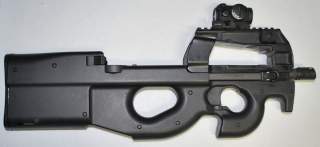The P90 Submachine Gun Is a Beast (What Came Before Was Just Strange)
As in some weird prototypes.
In the mid-1980s, Belgian firearms-maker Fabrique Nationale began working on a new personal-defense weapon. In time, it evolved into the iconic P90.
But not before producing several rather bizarre prototypes.
In 1989, NATO issued a specification for two personal-defense weapons — one a pistol and the other a shoulder-fired compact submachine gun. The pistol was to weigh less than one kilogram while the shoulder-fired weapon would weigh less than three kilograms.
Both weapons would fire a cartridge with improved range, accuracy and terminal ballistic performance compared to guns firing the nine-by-19-millimeter round.
NATO planned to equip rear-echelon troops — personnel who couldn’t carry or didn’t need a standard-issue rifle — with these new weapons. NATO believed that, in the event of war, Soviet special forces would attempt to disrupt Western lines of communication and logistics, so it was important to arm support troops with a weapon firing a round that could penetrate Soviet body armor at close range.
F.N.’s answer to this problem had been in development since 1986, gradually evolving from several unusual prototypes. The unifying aspects of the designs were the special SS90 cartridge and a high-capacity horizontal magazine.
Designers Jean-Paul Denis and Marc Neuforge had developed the new 5.7-by-28-millimeter SS90 round to replace the nine-by-19-millimeter cartridge that was then, and still is, common in submachine guns. F.N. hoped that a new weapon firing the SS90 round would suffer less recoil while retaining adequate stopping power.
The first F.N. prototype appears to have been a shoulder-fired design, while the second was a handheld, point-and-shoot weapon.
F.N. announced the development of the P90 in 1988. In 1989, Rene Predazzer patented a top-mounted horizontal magazine incorporating a spiral feedway that rotated the cartridge before it entered the weapon’s action. This loading system came to define the P90.
In 1992, F.N. refined the P90’s 5.7-by-28-millimeter ammunition, slightly shortening the projectile. A year later, F.N. redesigned the P90 and its magazine to chamber the SS190. The new aluminum-core SS190 round was 2.7 millimeters shorter than the round it replaced, but had slightly more mass.
In January 1995, Predazzer patented an unconventional pistol design incorporating his top-loading longitudinal magazine. This appears to be an evolution of the second handheld prototype and, in theory, fulfilled the pistol element of NATO’s personal-defense weapon specification. Several years later in 1998, F.N. launched development of a 5.7-by-28-millimter pistol, the Five-Seven.
It would be a decade before NATO finally evaluated the P90 submachine gun. In 2002, NATO testers pitted the F.N.’s 5.7-by-28-millimeter round against Heckler & Koch’s rival 4.6-by-30-millimeter round. The alliance found the F.N. round to be superior, but Germany rejected the trials’ recommendations and NATO declined to adopt either round.
The final P90 design uses a blowback action and fires from a closed bolt, which improves the weapon’s accuracy. Feeding from a 50-round magazine, the P90 is fully ambidextrous, with two sets of back-up sites — one on either side of its collimating optical sight — plus charging handles and magazine-release catches on either side and an ambidextrous safety located just below the trigger.
The design makes use of new polymers. The translucent magazine is made from polycarbonate.
Despite its unusual shape, the P90 is an ergonomic weapon and is easy to master. The P90 is an admirably flat-shooting automatic weapon despite its high cyclic rate of 900 rounds per minute.
More than a dozen countries have adopted the P90, primarily for special operations and counterterrorism units. Belgium is the only country to have adopted it for its original purpose — arming rear-echelon troops.
This article by Matthew Moss originally appeared at War is Boring in 2017.
Image: Wikipedia.

